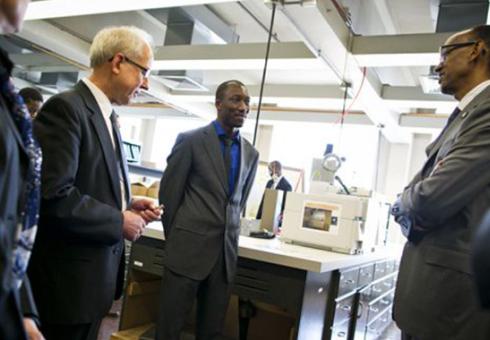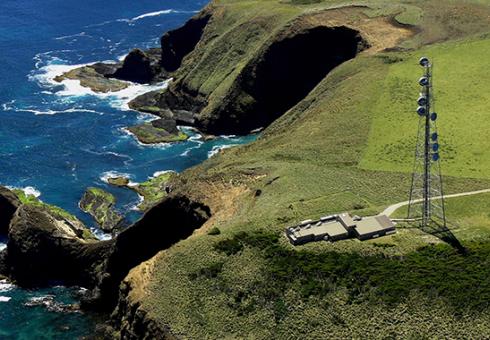News + Media
Multidisciplinary program, to be led by Susan Solomon, will encourage collaborations among researchers in different fields.
David Chandler
MIT News Office
MIT has announced a major new campuswide initiative to promote transformative, cross-disciplinary research relating to the environment.
The initiative will be formally launched in the fall, and its founding director will be Susan Solomon, the Ellen Swallow Richards Professor of Atmospheric Chemistry and Climate Science. Maria Zuber, MIT’s vice president for research and the E.A. Griswold Professor of Geophysics, stewarded the establishment of the new initiative, and expressed gratitude to Solomon for having agreed to serve as its first leader.
“Professor Solomon is one of the finest climate scientists in the world,” Zuber says. “Her service in the coming year will be of immense value to MIT, and to the world.” A search will be mounted for a permanent director to run the initiative after its first year.
A major component of the initiative will be the Abdul Latif Jameel World Water and Food Security Lab (J-WAFS), whose creation was announced this week; J-WAFS was established through a major gift from MIT alumnus Mohammed Abdul Latif Jameel. Headed by John Lienhard, the Jameel Professor of Water and Food, the lab is intended to help humankind adapt to a rapidly rising population, a changing climate, and increasing urbanization and development. The lab will work toward environmentally benign, scalable solutions for water and food supply across a range of regional, social, and economic contexts.
Regarding the environment initiative, Solomon says, “Our faculty, students, and staff have a deeply shared vision of being responsible stewards of the environment. This initiative will focus and amplify the aspirations of our community to understand, inform, and seek solutions to pressing problems of the natural world and built environment.”
This new initiative, she says, will promote research that engages wide participation by members of the MIT community to address the most significant interdisciplinary problems in our environment, spanning the physical and social sciences; engineering; and urban planning and policy.
“The goal of the initiative will be very specific: for faculty members to self-organize into teams of people who are interested in defining genuinely new research directions; to come up with ideas across schools; and to propose research that might not easily be funded by current federal agencies, which tend to be defined by disciplinary areas,” Solomon says. Such interdisciplinary research is recognized as a key way to bring about significant advances in technology and understanding.
Like the MIT Energy Initiative (MITEI), the new program is also expected to produce detailed, comprehensive studies in particular areas of concern — in this case, large-scale environmental issues. “Such studies by MIT would be welcomed on Capitol Hill,” Solomon says.“One of the most important challenges of our time is the question of how to build a sustainable human society,” MIT President L. Rafael Reif wrote in an email to the MIT community this morning. “The intense interest in this subject from our students and faculty reflects a shared sense of urgency and obligation. With Professor Solomon’s leadership, the environment initiative will help focus MIT’s distinctive strengths on advancing science, engineering, management, design and policy solutions to help drive the kind of progress required in time to make a difference.”
The initiative, which does not yet have a formal name, will start with funding for five years of operation, partly provided by MIT; after that it is expected to be self-sustaining, Solomon says. It will tie together research undertaken by many departments and centers at MIT, including, in addition to J-WAFS, the Department of Earth, Atmospheric and Planetary Sciences; the Department of Urban Studies and Planning; the Department of Civil and Environmental Engineering; the Center for Global Change Science; and the Earth System Initiative, among others. Some themes of the new initiative will link closely with ongoing efforts in MITEI, particularly on climate change and water.
The search for the director was announced in February by Provost Martin Schmidt. The search committee, chaired by Professor Markus Buehler, included Professors Rob van der Hilst, Eran Ben-Joseph, JoAnne Yates, and Melissa Nobles. Professors Robert Armstrong and Vladimir Bulović also served on the committee; they were asked to help think through coordination with existing MIT initiatives. The committee worked with students to get their input.
The initiative will put out a call for initial interdisciplinary proposals this fall, Zuber says, adding: “We want new ideas. MIT can bring its special talents to bear to address global concerns, in the process drawing in people from across the campus.”
Additionally, a group consisting of Solomon, Zuber, Schmidt, and Armstrong (who serves as director of MITEI) will lead a series of conversations around campus on how MIT should engage to address the issue of climate change. This activity will include a series of lectures by prominent speakers representing a diverse set of perspectives.
The initiative will place a high priority on engaging the many students whose interests center on the environment and sustainability issues, Solomon says.
“There are a lot of opportunities for synergies,” she continues. “The initiative will take advantage of the traditionally open atmosphere at MIT, which fosters interactions among people working in very different fields of study. That spirit of collaboration, and the possibilities it unleashes, are very powerful.”
Henry D. Jacoby, codirector emeritus of the Joint Program and coauthor of the National Climate Assessment comments on the report.
Global warming is rapidly turning America the beautiful into America the stormy, sneezy and dangerous, according to a new federal scientific report. And those shining seas? Rising and costly, the report says.
Climate change's assorted harms "are expected to become increasingly disruptive across the nation throughout this century and beyond," the National Climate Assessment concluded Tuesday. The report emphasizes how warming and its all-too-wild weather are changing daily lives, even using the phrase "climate disruption" as another way of saying global warming.
Still, it's not too late to prevent the worst of climate change, says the 840-page report, which the White House is highlighting as it tries to jump-start often stalled efforts to curb heat-trapping gases.
However, if the nation and the world don't change the way they use energy, "we're still on the pathway to more damage and danger of the type that are described in great detail in the rest of this report," said study co-author Henry Jacoby, co-director of the Joint Program on the Science and Policy of Global Change at the Massachusetts Institute of Technology. Jacoby, other scientists and White House officials said this is the most detailed and U.S.-focused scientific report on global warming.
Read the full story here
Henry D. Jacoby, codirector emeritus of the Joint Program, talks to Amanda Lang of the CBC's Lang and O'Leary Exchange about the findings of the Third National Climate Assessment.
Joint Program codirector emeritus Henry Jacoby appeared on CBC's The Lang & O'Leary Exchange to discuss the findings of the Third National Climate Assessment. Jacoby is a lead author of the report's chapter on mitigation. Watch the interview below.
Global Change researcher Michael Greenstone and coauthors write about the importance of natural experiments" in calculating the costs and benefits of environmental regulations."
Last week, a divided court of appeals upheld what may well be the most important environmental rule in the nation's history: the Environmental Protection Agency's mercury standards. The regulation is expected to prevent up to 11,000 premature deaths, 4,700 heart attacks and 130,000 asthma attacks a year.
Critics of the mercury rule have focused on its expense. The EPA estimates it will cost $9.6 billion a year, with most of the burden falling on electric utilities. Indeed, the issue of cost is what split the court.
The Clean Air Act allows the EPA to regulate electric utilities under its hazardous air pollutants program only if it finds that such regulation "is appropriate and necessary." Focusing solely on mercury's effect on public health, the EPA made that finding.
That troubled Judge Brett M. Kavanaugh. In his dissenting opinion, he asked, quite reasonably, how the EPA could possibly conclude that regulation is "appropriate" without considering costs. He argued that it's "just common sense and sound government practice" to take account of costs as well as benefits.
But the court's majority had an answer. It noted the EPA had considered costs — not in its initial decision on whether to regulate mercury emissions but in its second and crucial decision about how stringent the regulation should be. The court's majority also emphasized the benefits of the rule, which have been estimated to be worth from $37 billion to $90 billion, outweighing the costs by a factor of between 3 to 1 and 9 to 1.
For the future, the mercury controversy offers two lessons. The first is that no approach to environmental protection can afford to be indifferent to costs. In situations where Congress allows the EPA to take account of costs, the agency should do so, at least in considering the appropriate level of stringency.
The second lesson is more subtle. Calculations of the costs and benefits of a regulation should use the best available science. In the case of mercury, for example, the substance itself is a neurotoxicant, potentially affecting memory, language, attention and cognition. But it is not easy to quantify mercury's adverse effects, and the EPA did not try.
The massive benefits identified by the EPA are expected to come not from mercury reductions but from "co-benefits" — that is, from reductions in other air pollutants that will result from efforts to reduce mercury emissions.
The vast majority of the quantified benefits of the mercury rule are a product of incidental reductions in emissions of just one other pollutant: particulate matter. That's not all that surprising, given that reductions in particulate matter, which can cause serious health problems, accounted for about one-third to one-half of the total monetized benefits of all significant federal regulations from 2003 through 2012.
In coming years, the benefits of further reductions in particulate matter will be among the most contested issues in environmental regulation. No one doubts that particulate matter is harmful to human health, but we need answers to important questions about which particles are the most dangerous and how much damage they cause at low concentrations.
Increasingly, that will involve relying on so-called natural experiments to learn about the effects of pollution on health. Such experiments ask what happens to health when some practice or event (a regulatory action, for example) causes a significant, and sometimes abrupt, change in pollution for one group of people but leaves pollution unchanged for another, similar group of people.
One such study examined the health of two similar populations in China. One consisted of people who lived north of the Huai River, who received free, government-provided coal to heat their homes. The other was made up of people who lived south of the river and did not get free coal. Those heating their homes with the free coal were found to have life expectancies 5.5 years shorter than those who did not, due to the coal-generated particulate matter they inhaled.
A greater reliance on natural experiments would be an important improvement in regulatory policy. Currently, we rely on observational studies that, while informative, don't necessarily tell us what we need to know to determine a regulation's benefits. These studies compare health in places with high and low levels of pollution. But if, say, Los Angeles has higher levels of asthma than, say, Boise, Idaho, differences in the populations — such as people's socioeconomic status or health habits — rather than differences in air pollution may be responsible. Researchers try to control for those differences with rigorous statistical methods, but it is not always easy to do so.
The court's decision to uphold the EPA's mercury rule means that the American people will be able to enjoy significant health benefits. As we celebrate that decision, we should ensure that the best science is brought to bear on decisions that affect present and future occupants of the planet.
Francesca Dominici is a professor in the department of biostatistics at the Harvard School of Public Health. Michael Greenstone is a professor of environmental economics at the Massachusetts Institute of Technology. Cass R. Sunstein is a professor at Harvard Law School; he worked on the mercury rule while serving in the Obama administration from 2009 to 2012.
The planet is a complex system in which humans are playing an ever more important role in shaping the environment and the livability of the planet. The data, modeling, and analysis of data and model results requires a variety of visualization tools. Computational resources needed for the exercise are very large. A reason for this is the inherent uncertainty in our projections, and the need to represent that uncertainty with large ensembles of model projections using Monte Carlo techniques. This then further requires decision tools and techniques that lead to decisions that are robust in the face of uncertainty.
John Reilly speaks about the growing requirement for vast computational resources in the visualization and analysis of data and model results.
Yesterday, Paul Kagame, the president of Rwanda, visited MIT to discuss existing collaboration between his country and MIT, as well as to explore the possibility of broadening its scope. Kagame was traveling with Rwandan Ambassador to the United States Mathilde Mukantabana, Rwanda’s Permanent Secretary of the Ministry of Education Sharon Haba, and others of Rwanda’s leadership.
President Kagame and his delegation, together with Maria Zuber, MIT’s vice president for research and the E. A. Griswold Professor of Geophysics, and Philip Khoury, associate provost and the Ford International Professor of History, toured the laboratory of Professor Ronald Prinn, who leads the Rwanda-MIT Climate Change Observatory Project and is the TEPCO Professor of Atmospheric Science in the Department of Earth, Atmospheric, and Planetary Sciences.
Rwanda and MIT are collaborating to build a world-class observatory on Mt. Karisimbi measuring climate change and the atmospheric gases forcing climate change; the observatory is ultimately to be run by local researchers. The project evolved from discussions in 2008-2009 between President Kagame, his ministers, and the MIT administration.
Mt. Karisimbi will join the MIT-led multinational Advanced Global Atmospheric Gases Experiment (AGAGE) network that has been measuring atmospheric composition continuously over the globe since 1978. This unique new site can measure air coming from Rwanda and many other nations within and beyond Africa. Access to the 4,500-meter-high summit of Karisimbi will be facilitated by a new cable car being built for eco-tourism.
While the cable car is being built, an interim observatory has been set up on Mt. Mugogo to train the local technicians. Besides Prinn, Kat Potter, the station scientist, and doctoral student Jimmy Gasore are installing the first phase of instruments that measure temperature, winds, humidity, carbon dioxide, methane, carbon monoxide, ozone, and nitrous oxide. The second phase involves an automated mass spectrometer measuring over 50 other greenhouse gases and air pollutants. Rwandan researchers will gain the capability using computer codes to calculate regional greenhouse gas sources and sinks, climate change, and air pollution. The observatory data will be used for University of Rwanda student thesis projects, and Prinn is working with Rwandan faculty on a new Atmospheric and Climate Science master’s degree and undergraduate courses.
Rwanda will gain local capacity to adapt to climate change using the capability to forecast regional and local climate change to address the needs of local decision-makers; take advantage of revenue-yielding opportunities to mitigate climate change (such as reforestation and renewable energy using greenhouse gas sources and sink estimates); and grow a scientifically and technically educated work force that can address other important local and regional environmental and economic development issues.
Following the lab tour, Kagame and his delegation were received by MIT President L. Rafael Reif and Professor Zuber. Reif and Zuber were joined by leadership from parts of MIT that have active engagement or interest in Rwanda: the Jameel Poverty Action Lab (J-PAL); MIT D-Lab; and the MIT Energy Initiative (MITEI); and EAPS. In beginning the round-table discussion, Reif told Kagame and the rest of the meeting participants that an exploration of possibilities for new or enhanced collaboration would best center on three areas that bear directly on the well-being of Rwandans: the environment; online learning; and innovation and entrepreneurship.
MIT participants updated Kagame on current and possible engagements. Tavneet Suri, the Maurice F. Strong Career Development Professor and an associate professor of applied economics at the MIT Sloan School of Management, is the scientific director for Africa for J-PAL. She reminded Kagame of meetings held last year between J-PAL and Rwandan governmental ministers, and she described progress made on engagements currently under way; they include an effort to prevent HIV among adolescent girls, as well as work on a water-tank project. J-PAL is also helping Rwanda to build capacity for its senior civil servants and academics.
Robert Armstrong, the director of MITEI and the Chevron Professor of Chemical Engineering, provided an overview of MITEI’s work; he emphasized possibilities around solar research and work being done at MIT to explore how to provide energy for villages through the establishment of “microgrids.”
Kofi Taha, associate director of D-Lab, described the work of D-Lab and its focus on collaborating intensely with people to develop, side-by-side, the tools they need in order to improve lives. He expressed the hope that D-Lab might be helpful to the Rwandan government’s “Vision 2020,” an effort to transform Rwanda into a middle-income, knowledge-based economy by the year 2020.
Esther Duflo, the Abdul Latif Jameel Professor of Poverty Alleviation and Development Economics in the Department of Economics and founder and director of J-Pal, discussed the potential of online learning tools for teaching development economics and other subjects to those working to effect change. President Reif pointed out that though there are only a handful of Rwandan students at MIT, 1,700 Rwandans are taking courses through edX, the online learning platform founded by MIT and Harvard University.
President Kagame spoke of his desire to connect the discrete projects currently under way between MIT and Rwanda and to identify a clear set of further areas for collaboration, with Haba leading future discussions on behalf of his administration, and with the close involvement of the University of Rwanda. At the close of the meeting, Reif and Kagame agreed that the discussion showed good potential for greater collaboration.
John Reilly comments on the fortcoming IPCC report's take on slowing climate change.
Trust in technology: That seems to be the underlying message of a coming report from the world's top panel on climate change.
Scheduled for release on Sunday in Berlin, Germany, the new Intergovernmental Panel on Climate Change (IPCC) report will point to many possible ways—from burying greenhouse gases to going nuclear to encouraging biofuel production—to save humanity from the ravages of climate change.
[…]
A Hard Climb
A 1992 United Nations agreement broadly obligated the world to limit global temperature increases to 3.6 degrees Fahrenheit (2 degrees Celsius) over preindustrial levels. Some studies have noted significant dangers—chiefly, lower farm production—if the planet warms beyond that point.
"The most interesting and useful thing the new report could do would be in simply laying out all the paths we could take to not breach that limit," says MIT economist John Reilly. "Most people think it's very unlikely we are going to stay within that [3.6-degree] limit."
The IPCC Working Group 3 report, based on six years of economic and technology studies, will lay out innovations and reforms in power generation, industry, transportation, farming, and other fields that might help nations to reduce emissions. Yet many of the scenarios examined in the report also look at what the world might do if the 3.6-degree limit is passed and temperatures rise still higher.
"Based on the studies that are already out there, I think we can say the sooner emissions are reduced, the easier it becomes to reach those goals," Edmonds says.
Written by 235 scientists from 53 nations over four years, the report on climate change mitigation is the third in a series released in the past year. The IPCC has released such reports in groups every six to seven years since 1990.
IPCC reports synthesize scientific studies to present policy options to government leaders. The two earlier reports enumerated the near-certain evidence that greenhouse gas emissions are responsible for increasing temperatures worldwide over the last century, and detailed the impacts on people, wildlife, and the environment.
"The IPCC is not going to solve the political problem that is at the bottom of things," Reilly cautioned. "A lot of the studies [considered] in the report started from the premise that we already were doing something about carbon reduction. That didn't happen."
John Reilly says IPCC reports should integrate science, adaptation, and mitigation efforts.
By Stephanie Paige Ogburn
ClimateWire
Every seven years, the Intergovernmental Panel on Climate Change (IPCC) publishes three colossal reports about global warming.
The second of that set of three, focusing on impacts and adaptation, was just released, and on its heels have come calls for the structure of those reports to change.
On Friday, David Griggs, a professor and director of the Monash Sustainability Institute at Australia's Monash University, who has been involved in the last three IPCC reports, was the latest to weigh in with a proposal for reconfiguring the IPCC.
The comment, published in the journal Nature, addresses the burden the IPCC places on scientists, who volunteer their time, and the frequency of the reports.
Griggs argues for publishing shorter, less frequent reports, every 10 years, pointing out that the past three science reports from Working Group I have lengthened from 410 pages to 881 pages to 1,535 pages with the report released late last year.
[...]
Another past lead author, John Reilly, who is now co-director of the Joint Program on the Science and Policy of Global Change at the Massachusetts Institute of Technology, has also written on some of his frustrations with the report.
Reilly, who wrote about the topic in MIT Technology Review, believes the report would be more powerful if it integrated science, adaptation and mitigation rather than producing three separate efforts.
Looking for more focus
"I think streamlining the IPCC process would be extremely important. It has gotten extremely burdensome in terms of these three separate working groups all doing a lot of work. If anything, reduce it down to a single volume that better integrates the three elements of the problem," Reilly said.
He pointed out that if someone wants to learn about how climate change is affecting tropical storms and hurricanes, he or she would have to find that information inside the publication produced by the IPCC's Working Group I, which is focused on science.
"Then if you want to figure out how to adapt to them, you have to go to Working Group II and dig into several chapters," Reilly added.
Read more...




